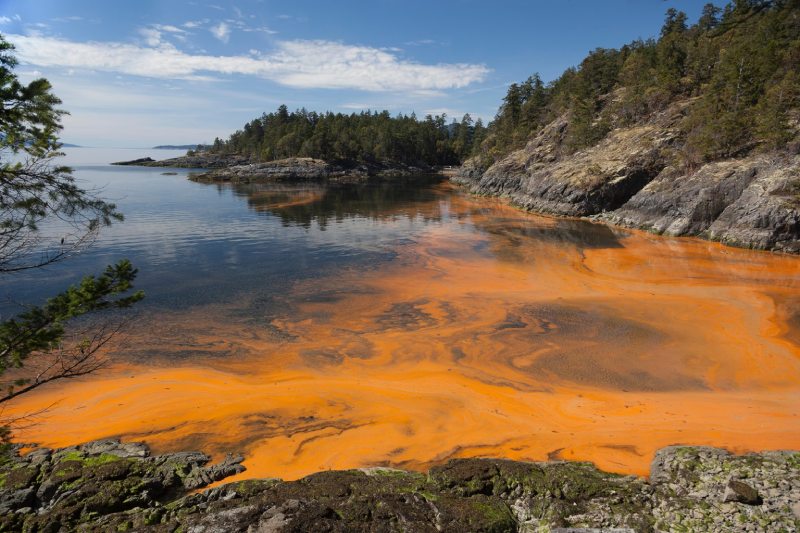World
David Hastings Explores Toxic Tides: The Impact of Harmful Algae Blooms in Florida

Florida, known as the Sunshine State, is well-known for its spectacular coastline, abundant marine life, and flourishing tourism business. However, underneath its beautiful and scenic surface, Florida meets a growing environmental risk – Harmful Algae Blooms (HABs). David Hastings says these toxic tides greatly endanger the state’s marine ecosystems, tourism, public health, and general environmental wellbeing.
Understanding Harmful Algae Blooms
Harmful Algae Blooms (HABs) result from the rapid and sudden growth of certain kinds of algae in waterways around the country. They are a problem in every coastal and Great Lake state in the U.S. In Florida, these blooms are primarily by two types of algae: Karenia brevis, responsible for turning parts of the ocean red, and different species of cyanobacteria, which cause harmful blue-green algae blooms. These tiny organisms, usually benign in small numbers, can increase explosively during the right conditions and grow out of control.
Various aspects contribute to the growth and problem of harmful algae blooms in Florida’s waters. Elevated water temperatures, nutrient-rich runoff from agriculture and urban areas, and changing salinity can make an environment that is conducive for these harmful algal blooms. Florida’s warm weather and extensive coastline make it susceptible to these harmful algal outbreaks.
Environmental Impact
Harmful Algae Blooms (HABs) in Florida’s waters have far-reaching and devastating consequences on the state’s delicate ecosystems. These outbreaks, also known more commonly as “red tides” because the ocean turn red, disrupt the fragile balance of coastal ecosystems and compromise the fitness and strength of many marine organisms, including fish, marine mammals, and corals.
Effects on Marine Life and Ecosystems
Kills Fish: One of the most alarming effects of HABs is the occurrence of killing fish. The toxins created by certain algae, such as Karenia brevis, which is responsible for red tide, can paralyze fish and other marine organisms. This immobility ultimately leads to their death. When HABs are particularly extreme, thousands of fish may wash ashore. The loss of marine life disrupts the food web, involving predators, scavengers, and decomposers.
Marine Mammal Strandings: HABs also pose a notable menace to marine mammals, including dolphins, manatees, and sea turtles. When these animals consume infected fish or are exposed to poisons in the water, they can undergo debilitating health results. Marine mammal strandings, where these animals become stranded on shores or display abnormal conduct, often overlap with HAB occurrences.
Impact on Coral Reefs: Florida’s coral reefs, among the most biodiverse aquatic ecosystems, are not immune to the effects of HABs. Algal toxins can harm corals, leading to coral bleaching and decreased biodiversity. Coral reefs play a vital part in healthy habitats for numerous marine species and saving coastal areas from storm surges, making their loss a considerable concern.
Harmful Algal Blooms and Water Quality
Drinking Water Quality: HABs can have direct effects on drinking water. Some HAB species, particularly cyanobacteria, discharge toxins that can contaminate freshwater bodies. Water treatments may not remove these toxins completely, posing a public health risk. Consequently, residents in impacted areas may be advised to use alternative water supplies or resort to specialized treatment to ensure their water is safe to drink.
Recreational Water Quality: Florida’s pristine beaches and recreational beachfronts attract millions of visitors each year. During HABs, water grade can deteriorate considerably. Algal blooms often develop unsightly and unappealing situations for beachgoers, as the water may become fady and foamy with an acrid stench due to rotting fish. Swimming, boating, and other water-based sports can be discouraged or prohibited due to toxins and their probable health threats.
Economic Consequences
Florida’s economy relies on its inherent natural beauty and its tourism business, making the economic impacts of toxic Algae Blooms particularly significant. When toxic algal blooms occur, the state’s tourism business can decline due to the unsightly appearance and foul smell associated with algal blooms and decomposing fish. Travelers may be prevented from seeing affected areas, reducing earnings for local businesses.
Florida’s seafood and fishing businesses also suffer from substantial losses during algae blooms. Commercial and recreational fishing can be severely affected due to algal toxins. This impacts fishermen’s livelihoods and reduces the availability of locally sourced seafood for shoppers and restaurants.
The costs associated with managing harmful algae bloom related health problems and cleaning up affected areas can impact local government budgets. These economic repercussions emphasize the importance of managing and controlling HABs in Florida’s waters.
Human Health Implications
Harmful Algae Blooms harm marine ecosystems and threaten human health. The toxins by some algae during blooms can become airborne, leading to respiratory issues when inhaled. People living near affected water bodies may experience coughing, sneezing, and eye irritation due to vulnerability to these aerosolized toxins.
Additionally, contact with contaminated water can cause skin inflammations and gastrointestinal problems. Consuming water or seafood infected with HAB toxins can lead to more severe health matters, including liver and nerve injury. Therefore, monitoring and public health advisories are vital to underestimate the health risks to residents and visitors during harmful algae bloom occurrences.
Long-term health issues related to harmful algae blooms are a subject of ongoing research. While acute symptoms are more readily recognizable, the possibility of chronic health risks from repeated exposure to HAB toxins is a growing concern that necessitates additional study.
Government and Community Responses
Addressing Harmful Algae Blooms in Florida requires a multi-pronged strategy involving government agencies, communities, and concerned citizens. Some government agents at the state and federal level are implicated in monitoring, analyzing, and supervising harmful algae blooms. These specialists work together to track HAB events, case signs, and advisories and coordinate reaction measures.
Mitigation and prevention strategies are essential to managing harmful algae blooms in Florida. These contain measures to reduce nutrient pollution, a primary driver of algal blooms. Principles and best management techniques for agriculture, wastewater treatment, and urban growth aim to restrict the inflow of nutrients into water bodies.
Community and citizen involvement are also vital. Public understanding events enlighten residents and visitors about the risks of HABs and how to stay safe during bloom events. Scientists contribute valid data through water quality monitoring schedules, assisting in tracking the presence of harmful algae blooms and their effects.
Research and Innovation
Ongoing investigations are fundamental to addressing the problematic matter of harmful algae blooms. Scientists are analyzing the dynamics of HABs, including their causes and ecological impacts, to develop more effective prevention and comeback strategies. Creative technologies for early detection and supervising HABs are being developed, allowing faster and more accurate assessment of bloom situations.
Nutrient reduction strategies, such as advanced wastewater therapy and stormwater management, are also being studied to reduce the nutrient runoff that fuels HABs. Additionally, techniques for fixing and protecting natural buffers like wetlands and mangroves can assist in mitigating the effects of nutrient pollution and algal blooms.
As Florida grapples with toxic algal blooms, it is crucial to prioritize analysis, prevention, and societal involvement. Only through scientific innovation, government activity, and public understanding can Florida hope to combat the toxic tides and protect the extraordinary and breathtaking beaches for both humans and marine life.
-

 Business3 weeks ago
Business3 weeks agoPrakash and Kamal Hinduja: Driving Social and Environmental Change
-
Education4 weeks ago
Fred DuVal: University Leadership as a Critical Resource for Climate Change Research and Life-Saving Solutions
-

 Health3 weeks ago
Health3 weeks agoThe Hinduja Brothers Commitment to Global Health: Empowering Communities Across Borders
-

 Cryptocurrency3 weeks ago
Cryptocurrency3 weeks agoDesigned For The Masses: How Akasha (AK1111) Is Unlocking Crypto For The Next Billion Users
-

 Cryptocurrency4 weeks ago
Cryptocurrency4 weeks agoNexaglobal & Future World Token (FWT): Could This Be the Next Big Crypto Investment of 2025?
-

 Sports4 weeks ago
Sports4 weeks agoWomen’s NCAA Tournament 2025 Sweet 16: Full Schedule, Fixtures, Teams, Bracket, and How to Watch March Madness Basketball Match Live
-

 Startup1 week ago
Startup1 week agoCost-Saving Strategies Every Small Business Owner Should Know to Boost Efficiency
-

 Startup3 weeks ago
Startup3 weeks agoMatthew Denegre on the Art of Deal Sourcing: Finding the Right Investment Opportunities

















